Transform your bathroom into a serene sanctuary with Japandi design – the perfect fusion of Japanese minimalism and Scandinavian functionality. This trending aesthetic combines clean lines, natural materials, and calming neutral tones to create spaces that feel both zen-like and incredibly practical.
We’ve discovered that Japandi bathrooms aren’t just beautiful – they’re groundbreaking. The style emphasizes quality over quantity, featuring warm woods like teak and oak alongside crisp whites and soft grays. Every element serves a purpose while contributing to an overall sense of tranquility that makes your daily routines feel more like self-care rituals.
Whether you’re planning a complete renovation or simply want to refresh your existing space, we’ll show you how to achieve this coveted look. From selecting the right fixtures and finishes to incorporating natural textures and strategic storage answers, these Japandi bathroom ideas will help you create a harmonious retreat that balances form and function effortlessly.
Essential Elements of Japandi Design Philosophy for Bathrooms
Japandi bathroom design centers on three fundamental principles that create serene, functional spaces. These core elements work together to transform any bathroom into a peaceful sanctuary.
Minimalist Aesthetic Principles
Clean lines define every element in a Japandi bathroom, from vanity edges to mirror frames. We embrace the “less is more” philosophy by selecting fixtures with simple geometric shapes and avoiding ornate details. Storage answers hide behind flush-mount cabinets that maintain unbroken wall surfaces.
Functional furniture serves multiple purposes while maintaining visual simplicity. A wooden stool doubles as seating and towel storage, while floating shelves display only essential items like organic cotton towels or bamboo accessories. We eliminate unnecessary decorative objects that create visual clutter.
Open spaces breathe between each element to prevent overcrowding. Floor space remains unobstructed around the bathtub and shower areas, creating a sense of spaciousness even in compact bathrooms. Wall-mounted vanities enhance this floating effect by revealing floor space underneath.
Natural Material Integration
Wood textures bring warmth through teak shower benches, cedar vanity tops, and bamboo storage baskets. We select sustainably sourced timber with visible grain patterns that add organic character without overwhelming the space. Light woods like birch and ash complement the minimalist aesthetic perfectly.
Stone surfaces provide grounding elements through river rock shower floors, marble countertops, and slate accent walls. Natural stone variations create subtle visual interest while maintaining the neutral color scheme. We choose honed finishes over polished ones to reduce glare and create softer reflections.
Ceramic and porcelain fixtures feature handcrafted textures that mimic natural materials. Matte glazes on tiles and sinks eliminate harsh reflections while adding tactile appeal. We incorporate woven elements like jute bath mats and linen shower curtains to soften hard surfaces.
Neutral Color Palette Foundation
Warm whites serve as the primary base for walls, ceilings, and major fixtures throughout Japandi bathrooms. We select creamy off-whites and soft ivory tones rather than stark bright whites to create a cozy atmosphere. These foundation colors reflect natural light beautifully while maintaining brightness.
Earth tones add depth through carefully chosen accent pieces like terracotta planters, sage green towels, and mushroom gray storage containers. Muted beiges and gentle taupes appear in wood finishes and natural stone selections. We limit bold colors to single accent pieces like a single potted plant or organic soap dispenser.
Black elements provide contrast sparingly through hardware, fixtures, and frames. Matte black faucets, drawer pulls, and mirror frames create definition without dominating the space. We use charcoal grays in tile grout and shower fixtures to bridge the gap between warm and cool tones.
Natural Wood Accents That Transform Your Bathroom Space
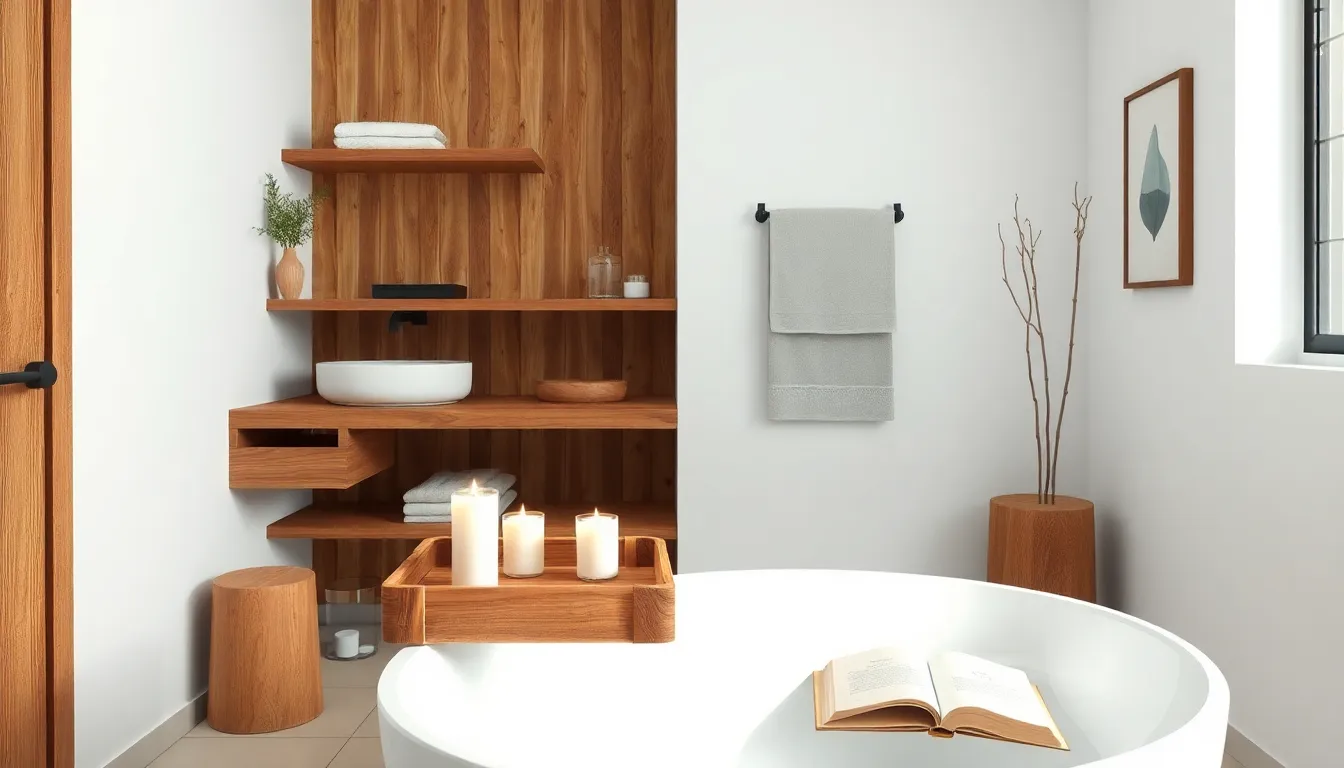
Wood accents serve as the cornerstone of Japandi bathroom design, bringing warmth and organic texture to create a harmonious retreat. These natural elements establish a connection with nature while maintaining the clean lines essential to this aesthetic.
Bamboo Vanity Installations
Bamboo vanities offer sustainable elegance with their distinctive grain patterns and naturally light coloring. We recommend wall-mounted or floating bamboo units that maximize floor space while maintaining the uncluttered aesthetic central to Japandi design. Bamboo’s remarkable durability makes it exceptionally suited for humid bathroom environments, resisting moisture damage that often affects other wood types.
Installation of bamboo vanities requires careful consideration of plumbing placement to achieve the floating effect that defines this style. Solid bamboo construction provides longevity, while the material’s neutral tones complement white fixtures and earth-based color schemes. These vanity units typically feature clean geometric forms without ornate details, allowing the natural wood grain to serve as the primary visual interest.
Wooden Bath Caddy Answers
Wooden bath caddies transform ordinary bathing experiences into spa-like retreats through practical luxury. We suggest selecting solid wood or bamboo caddies that span tub edges, providing dedicated storage for candles, soaps, and reading materials. These accessories showcase craftsmanship while serving essential organizational functions.
Cedar and teak emerge as premium choices for bath caddies due to their natural water resistance and aromatic properties. Adjustable width mechanisms ensure compatibility with various tub sizes, while built-in slots accommodate wine glasses, tablets, or books. Regular oiling maintains the wood’s appearance and extends lifespan, making these caddies both beautiful and practical additions to Japandi bathrooms.
Cedar Shelving Systems
Cedar shelving introduces natural pest resistance and moisture tolerance that makes it ideal for bathroom storage answers. We install floating cedar shelves to display towels and decorative objects while maintaining visual openness crucial to Japandi aesthetics. Cedar’s natural oils provide antimicrobial properties that enhance bathroom hygiene.
Recessed cedar shelving maximizes storage without protruding into the space, preserving clean wall lines that define this design philosophy. Open shelving concepts allow for strategic display of neutral-toned linens and minimal decor pieces. Cedar’s warm tones create visual contrast against white walls while remaining within the natural color palette that characterizes successful Japandi implementations.
Stone and Ceramic Features for Authentic Japandi Appeal
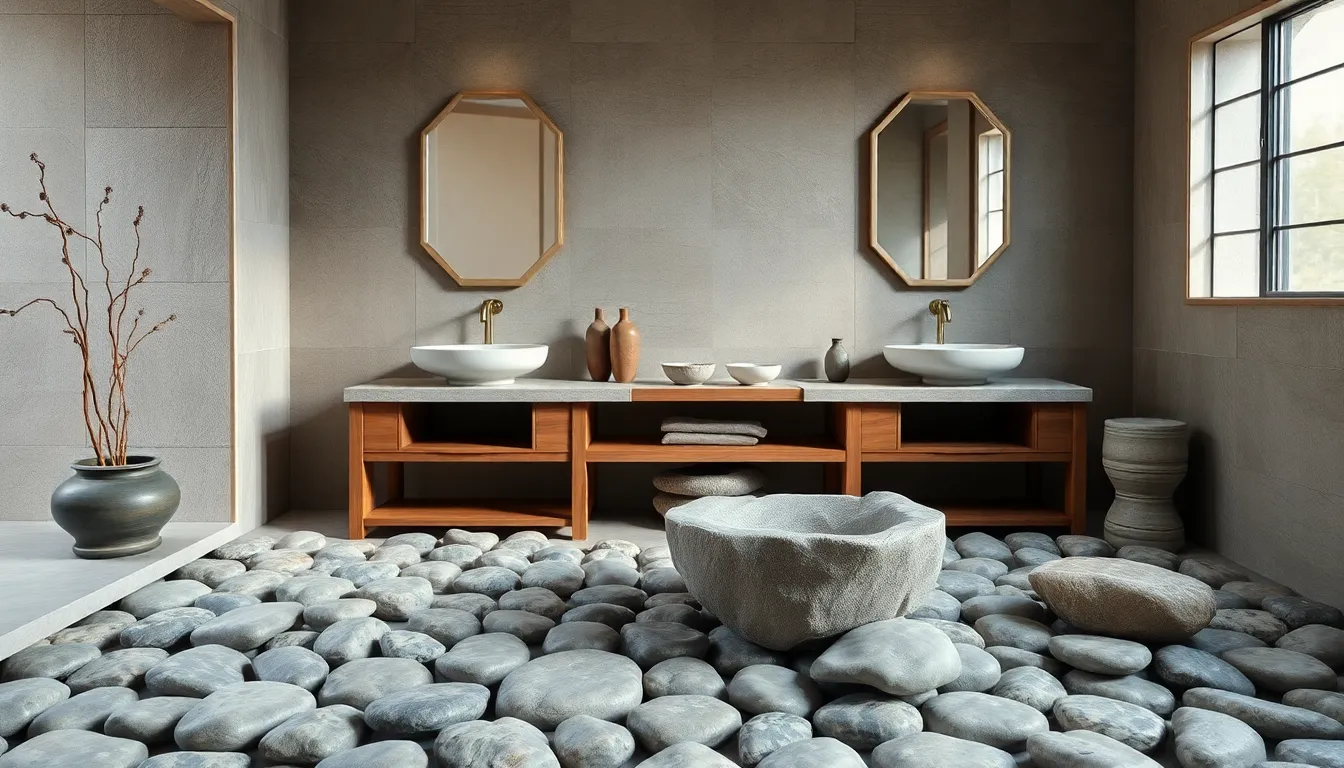
Stone and ceramic elements form the foundation of authentic Japandi bathroom design, bringing together the natural textures and artisanal craftsmanship that define this aesthetic.
River Rock Flooring Options
River rock flooring transforms your bathroom floor into a natural sanctuary that perfectly embodies Japandi principles. These smooth, rounded stones create an immediate connection to nature while providing a unique tactile experience underfoot. We recommend selecting river rocks in neutral tones like gray, beige, or charcoal to maintain the calming color palette essential to this design style.
Installation options include loose river rock tiles for easier maintenance or embedded stones in concrete for a seamless look. The natural variation in each stone adds organic visual interest without overwhelming the minimalist aesthetic. River rock flooring works exceptionally well in shower areas where the stones provide natural drainage and slip resistance.
Handcrafted Ceramic Vessels
Handcrafted ceramic vessels serve as functional art pieces that introduce authentic artisanal elements to your Japandi bathroom. These pieces showcase the beauty of imperfection, known as wabi-sabi in Japanese philosophy, through subtle variations in shape and glaze. We particularly love ceramic vessel sinks that sit atop natural wood vanities, creating a stunning contrast between materials.
Decorative ceramic vessels can hold bath salts, cotton balls, or small plants, adding both function and visual appeal to your space. Look for pieces with matte finishes in earth tones or pure white to complement the Japandi color scheme. The handmade quality of these vessels brings warmth and personality to an otherwise minimalist environment.
Natural Stone Countertops
Natural stone countertops provide durability and timeless beauty that align perfectly with Japandi’s emphasis on quality and sustainability. Marble, granite, and soapstone each offer unique characteristics that enhance the authentic appeal of your bathroom design. Soapstone delivers exceptional heat resistance and develops a natural patina over time, embodying the Japandi appreciation for materials that age gracefully.
We recommend selecting stones with subtle veining and neutral coloring to maintain visual harmony. These countertops pair beautifully with wooden vanities and ceramic fixtures, creating the material diversity that makes Japandi design so compelling. The natural variations in stone ensure that each installation becomes a unique focal point while maintaining the overall sense of calm.
Lighting Solutions That Embrace Japandi Bathroom Ideas
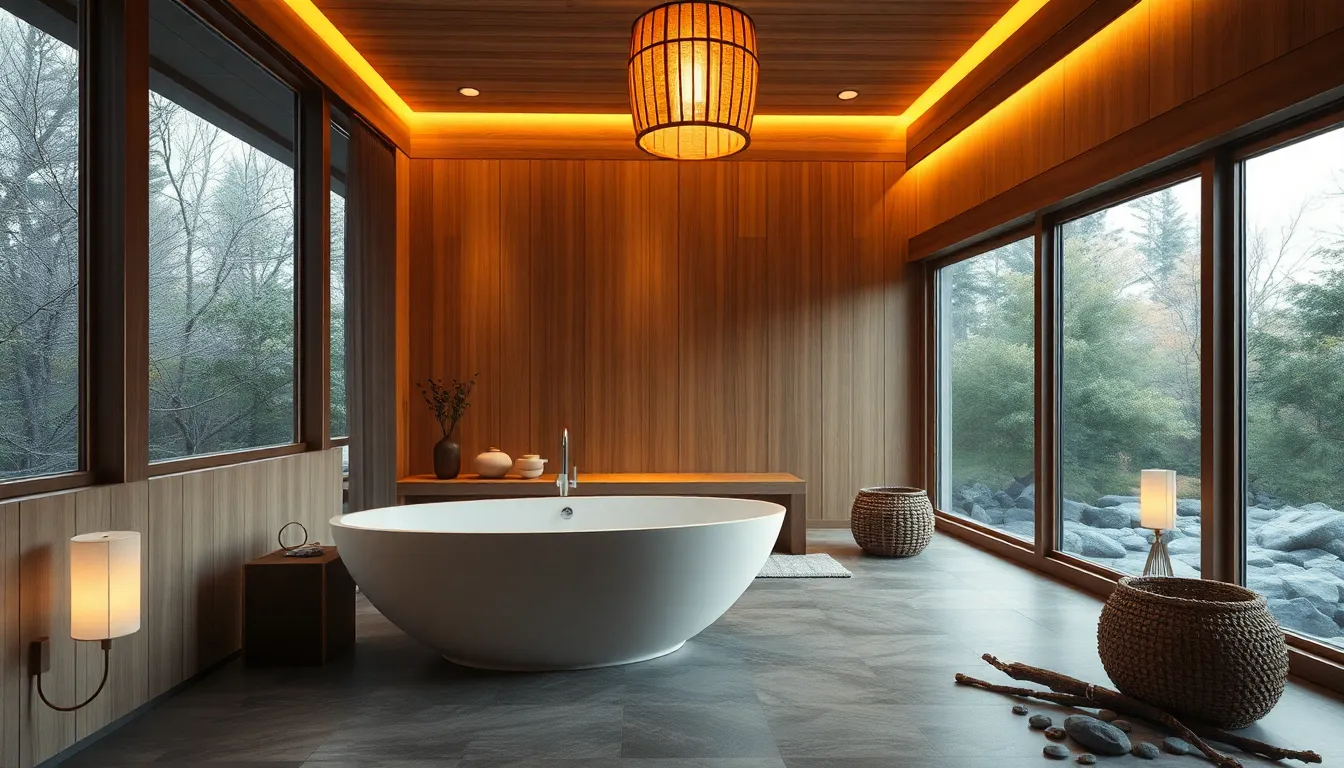
Lighting forms the foundation of authentic Japandi ambiance, creating layers of warmth that complement natural materials and neutral palettes. We’ll explore three essential approaches that transform your bathroom into a serene sanctuary.
Warm LED Ambient Lighting
Warm LED ambient lighting serves as the cornerstone of Japandi bathroom illumination, creating that coveted cozy atmosphere through strategic placement. We recommend installing integrated LED strips under floating vanities to cast gentle upward light that highlights wood grain textures. Built-in lighting around bathtubs provides soft, diffused illumination that enhances the beauty of natural stone surfaces.
These fixtures work particularly well when positioned to emphasize the warm tones of bamboo accents or cedar shelving systems. Dimmable warm LEDs allow you to adjust brightness levels throughout the day, maintaining the minimalist aesthetic while providing functional task lighting. The key lies in hiding the light sources themselves, letting the warm glow appear to emanate naturally from architectural elements.
Paper Lantern Fixtures
Paper lantern fixtures offer an interesting fusion element that bridges Japanese tradition with modern Japandi sensibilities, though they require careful consideration in humid bathroom environments. We suggest selecting moisture-resistant paper alternatives or positioning these fixtures in well-ventilated areas away from direct water exposure. Pendant-style paper lanterns work beautifully over freestanding tubs, creating focal points that embody the wabi-sabi philosophy.
These fixtures complement handcrafted ceramic vessels and other artisanal elements while maintaining the clean lines essential to Japandi design. Choose neutral-toned lanterns in whites or warm beiges to align with your established color palette. The soft, filtered light they provide enhances the organic textures of natural materials without overwhelming the minimalist space.
Natural Light Maximization Techniques
Natural light maximization forms the most crucial aspect of Japandi bathroom design, with skylights and larger windows serving as primary sources of illumination that highlight natural materials. We recommend installing skylights above bathing areas to create dramatic light patterns that shift throughout the day, emphasizing the serenity of your neutral color scheme. Strategic mirror placement amplifies available natural light, creating illusions of expanded space that align with minimalist principles.
Floor-to-ceiling windows work exceptionally well when privacy allows, flooding the space with sunlight that showcases river rock flooring and natural stone countertops. Sheer window treatments in organic fabrics filter harsh light while maintaining the connection to nature. These techniques reduce reliance on artificial lighting during daylight hours, supporting the sustainable philosophy inherent in Japandi design.
Storage Solutions That Maintain Clean Lines

Effective storage forms the backbone of any successful Japandi bathroom design. We’ll explore how to maximize functionality while preserving the serene minimalism that defines this aesthetic.
Hidden Cabinet Designs
Hidden cabinets serve as the ultimate solution for maintaining minimalism in our Japandi bathroom spaces. These seamlessly integrated storage units blend directly into wall surfaces, providing extensive storage capacity without disrupting the clean visual flow.
Push-to-open mechanisms eliminate the need for visible handles, allowing cabinet doors to sit flush against walls. We recommend installing these systems behind mirrors or within recessed wall areas to maximize their concealment effect. Soft-close hinges prevent jarring sounds that would disturb the peaceful atmosphere we’re cultivating.
Built-in niches work exceptionally well for storing toiletries and towels while maintaining architectural integrity. These recessed storage areas can be lined with natural stone or wood to complement our material palette. Integrated lighting within these spaces adds functionality without introducing additional fixtures.
Minimalist Floating Shelves
Floating shelves represent a hallmark element of Japandi design, offering simple display answers for our bathroom essentials. These wall-mounted storage pieces create visual lightness while providing practical space for towels and decorative items.
Wooden shelves crafted from oak or bamboo complement the natural material focus of our design approach. Glass shelving options work particularly well in smaller bathrooms where we need to maintain visual openness. The key lies in selecting shelves with invisible mounting systems that don’t interrupt the clean lines.
Strategic placement above the toilet or adjacent to the vanity maximizes storage potential without overwhelming the space. We suggest limiting ourselves to 2-3 floating shelves per bathroom to maintain the minimalist aesthetic. Each shelf should serve a exact purpose while contributing to the overall harmony.
Basket Organization Systems
Basket storage introduces organic warmth to our Japandi bathroom while providing practical organization answers. These woven containers can be positioned under floating shelves or tucked into corners to store toiletries and smaller items.
Natural materials like rattan, bamboo, or seagrass align perfectly with our sustainable design philosophy. We recommend choosing baskets with clean geometric shapes rather than overly decorative patterns. Neutral tones ensure these storage answers blend seamlessly with our color palette.
Lidded baskets work particularly well for concealing personal items while maintaining accessibility. Open baskets can display rolled towels or washcloths as functional decor elements. The texture these containers provide helps balance the smooth surfaces of stone and ceramic throughout our space.
Plant Integration for Organic Bathroom Atmospheres
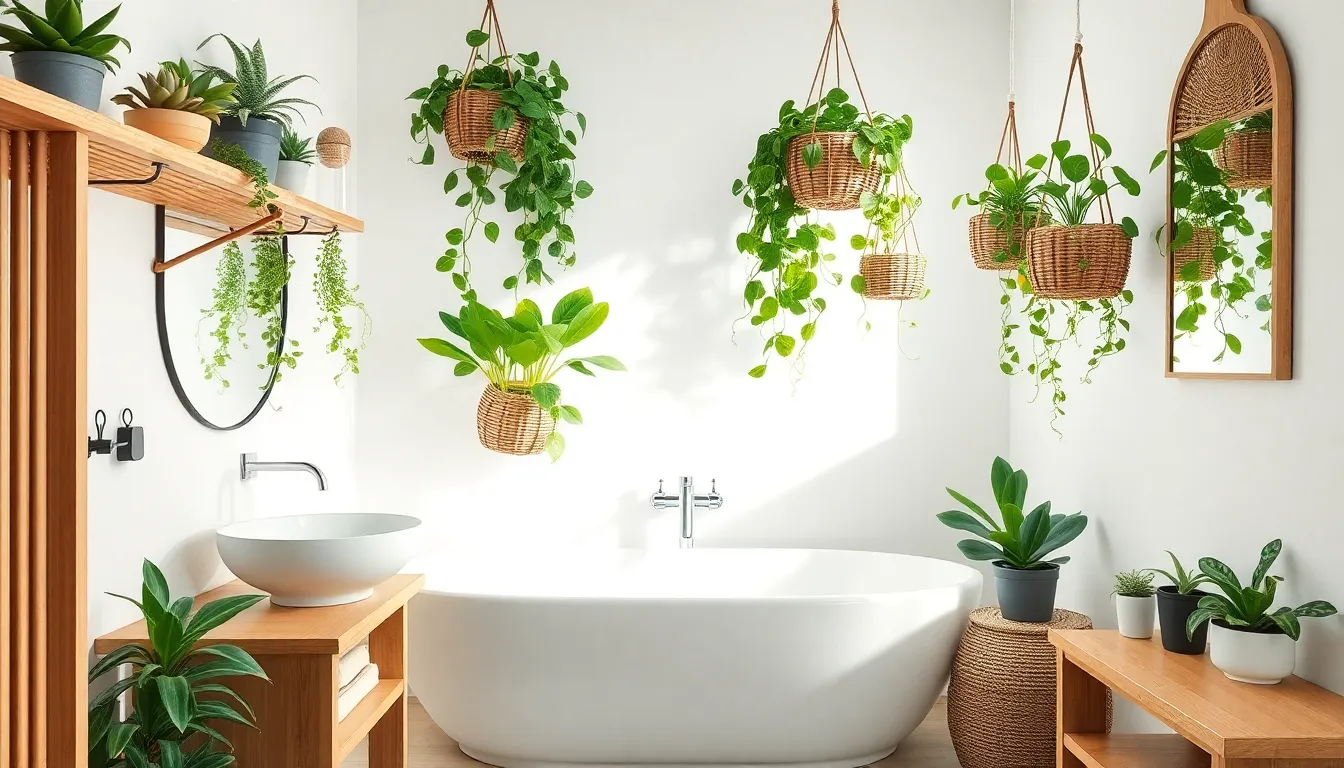
Living greenery connects our Japandi bathroom design to nature while improving the space’s biophilic appeal. Plants purify the air and maintain the calming ambiance that’s central to this minimalist aesthetic.
Low-Maintenance Greenery Options
Succulents thrive in bathroom environments because they adapt well to low light conditions and require infrequent watering. These hardy plants store water in their leaves, making them perfect for busy homeowners who want greenery without constant maintenance.
Air plants offer another excellent choice since they require minimal care and can be mounted directly on walls or placed in decorative containers. We recommend positioning them near windows where they’ll receive adequate light while adding visual interest to empty wall spaces.
Pothos brings versatility to our plant selection because it grows successfully in various lighting conditions and tolerates occasional neglect. This trailing plant works beautifully when placed on high shelves or floating surfaces, creating natural cascading elements that soften hard bathroom edges.
Hanging Plant Displays
Hanging baskets made from natural materials like wicker or bamboo create visually appealing displays that complement the Japandi aesthetic perfectly. We suggest selecting baskets with clean lines and neutral tones that won’t compete with the bathroom’s minimalist design.
Macramé hangers add bohemian elegance while maintaining the space’s serene vibe through their organic textures and neutral colors. Position these at varying heights to create visual depth without cluttering the room’s clean lines.
Wall mounted planters maximize floor space while bringing plants to eye level where they’ll have the greatest visual impact. Choose ceramic or wooden containers that echo other natural materials used throughout the bathroom design.
Small Succulent Arrangements
Mini planters crafted from wood or ceramic materials create neat and organized displays perfect for bathroom shelves or countertops. We recommend grouping planters in odd numbers for the most visually pleasing arrangements while maintaining the space’s uncluttered appearance.
Grouping multiple succulents together in larger planters enhances visual interest without overwhelming the minimalist environment. Select plants with varying heights and textures to create natural focal points that draw the eye while staying true to Japandi principles.
Wooden display trays help organize individual succulent pots while adding another layer of natural material to the design scheme. These trays prevent water damage to surfaces while keeping arrangements tidy and easily moveable for cleaning purposes.
Color Schemes That Perfect the Japandi Look
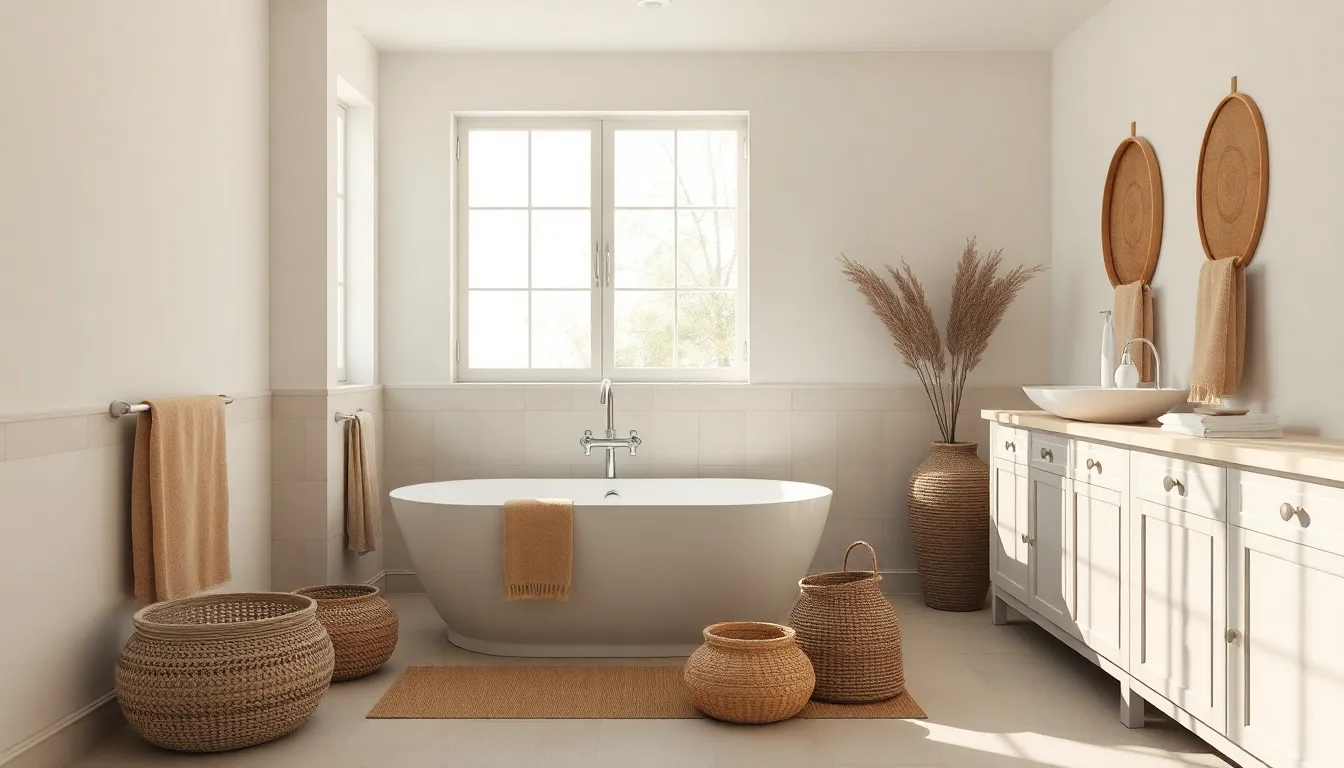
The right color palette serves as the foundation for creating an authentic Japandi bathroom atmosphere. We’ll explore three essential color approaches that capture the essence of this design philosophy while maintaining the serene functionality you’re seeking.
Warm White Base Tones
Warm white base tones create the perfect neutral foundation that allows natural materials and textures to take center stage. We recommend choosing whites with subtle undertones like ivory, cream, or soft pearl rather than stark clinical whites. These warmer variations provide depth and prevent the space from feeling cold or sterile.
Paint your walls in these warm white shades to establish visual continuity throughout the bathroom. Consider using the same warm white for ceiling treatments to create height and openness. Ceramic tiles in warm white hues work beautifully for shower surrounds and backsplashes, offering both practicality and aesthetic appeal.
White fixtures like pedestal sinks and freestanding tubs complement this base palette perfectly. Choose pieces with soft curves rather than sharp angles to maintain the organic flow essential to Japandi design. Natural light enhances warm white tones throughout the day, creating subtle variations that add visual interest without overwhelming the minimalist aesthetic.
Earthy Beige Accents
Earthy beige accents add warmth and depth to your Japandi bathroom while complementing the natural wood elements we’ve discussed earlier. We suggest incorporating these tones through textiles like bath mats, towels, and window treatments in linen or cotton materials. Stone colored ceramics and pottery also introduce beige tones while serving functional purposes.
Sandy beige paint colors work well for accent walls, particularly behind floating vanities or in shower niches. These warm neutrals create visual anchors without disrupting the overall calm atmosphere. Consider beige colored natural stone like travertine or limestone for flooring materials that ground the space with earthy sophistication.
Woven baskets in natural beige fibers provide both storage answers and color consistency throughout the room. Choose varying shades of beige from light sand to deeper taupe to create subtle layers within your color scheme. This approach maintains visual harmony while preventing the space from appearing flat or monotonous.
Soft Gray Combinations
Soft gray combinations provide the perfect balance between warmth and coolness in your Japandi bathroom design. We recommend selecting grays with warm undertones rather than cool blue based grays to maintain the cozy atmosphere. Light dove gray works exceptionally well for cabinetry and built in storage answers.
Concrete colored tiles in soft gray tones create beautiful accent areas around bathtubs or as shower flooring. These natural looking surfaces complement both wood and stone elements while adding contemporary sophistication. Gray colored natural stones like slate or soapstone introduce this palette through countertops and accent walls.
Combine different shades of soft gray to create depth without overwhelming the minimalist principles. Charcoal gray can serve as grounding accents through hardware, fixtures, or small decorative elements. This layered approach to gray tones maintains the calm environment while providing visual structure that guides the eye through your carefully curated space.
Fixture Selections for Modern Japandi Bathrooms

Selecting the right fixtures forms the foundation of our Japandi bathroom transformation. We’ll focus on three essential elements that embody both Japanese simplicity and Scandinavian functionality.
Freestanding Soaking Tubs
Freestanding soaking tubs serve as stunning focal points that transform our bathroom into a spa-like sanctuary. Natural wood materials like cedar or teak create the most authentic Japandi aesthetic while providing exceptional durability in wet environments. We recommend positioning these tubs near windows to maximize natural light and enhance the serene bathing experience.
Deep soaking capabilities define the traditional Japanese bathing philosophy within our modern space. Stone composite materials offer another excellent option, with their smooth surfaces and neutral tones complementing the minimalist design principles. These tubs typically range from 60 to 72 inches in length, providing ample space for a relaxing soak while maintaining visual balance in the room.
Oval shapes work particularly well in Japandi bathrooms, creating soft lines that contrast beautifully with angular fixtures. Installation on natural stone or wooden platforms elevates the design while providing practical storage underneath for towels and bath essentials.
Vessel Sink Installations
Vessel sinks deliver the perfect combination of minimalist aesthetics and practical functionality that defines our Japandi approach. Ceramic and porcelain options in matte white or warm beige tones create visual harmony with our neutral color palette. We prefer circular or oval shapes that echo the gentle curves found throughout nature.
Placement on floating wooden vanities maximizes floor space while maintaining the clean lines essential to this design style. Natural materials like bamboo or oak complement the vessel sink’s organic form, creating a cohesive look that feels both modern and timeless. These installations work particularly well when positioned slightly off center to create visual interest without overwhelming the space.
Height considerations play a crucial role in vessel sink functionality and comfort. Standard counter height plus the vessel depth should total between 32 to 36 inches for optimal ergonomics. Stone countertops provide an excellent base, with materials like soapstone or marble adding subtle texture and natural variation.
Minimalist Faucet Designs
Minimalist faucet designs emphasize clean geometry and essential function while eliminating unnecessary decorative elements. Single handle wall mounted configurations offer the most streamlined appearance, reducing visual clutter on countertops and vanity surfaces. We recommend matte black or brushed stainless steel finishes that create subtle contrast against neutral backgrounds.
Angular spouts and geometric bases reflect the Japanese influence while maintaining Scandinavian practicality. These fixtures typically feature single lever operation for easy temperature control and water conservation. Motion sensor technology can be integrated seamlessly for a truly modern experience that aligns with sustainability values.
Positioning at appropriate heights ensures both visual appeal and practical use throughout our daily routines. Wall mounted installations should sit 6 to 8 inches above the sink rim for optimal water flow and splash prevention. Deck mounted options work well with vessel sinks when the spout height allows comfortable hand washing without excessive reach.
Textile Choices That Complete the Japandi Aesthetic

Textiles bridge the gap between hard surfaces and soft comfort in Japandi bathroom design. We’ll explore how natural fiber selections enhance the serene functionality while maintaining the minimalist principles we’ve established.
Natural Fiber Bath Mats
Cotton bath mats create the foundation for our textile approach, offering moisture absorption while maintaining the organic aesthetic. These natural fiber options resist mildew buildup and provide gentle texture underfoot, perfectly complementing the warm wood accents and stone features we’ve incorporated.
Sisal mats bring exceptional durability to high traffic areas, featuring naturally antimicrobial properties that align with Japandi’s emphasis on clean, healthy living spaces. Their neutral tan coloring works seamlessly with our established earth tone palette, while the textured surface adds subtle visual interest without overwhelming the minimalist design.
Bamboo fiber mats represent the ultimate sustainable choice, drying quickly and maintaining their shape even in humid bathroom environments. We recommend positioning these mats near vessel sinks and freestanding tubs to create defined zones while preserving the open floor plan essential to Japandi aesthetics.
Linen Towel Collections
Pure linen towels embody the Scandinavian functionality aspect of Japandi design, becoming softer with each wash while maintaining their natural texture and absorbent qualities. Their relaxed, lived in appearance supports the wabi sabi philosophy we’ve woven throughout our fixture selections and natural material choices.
Stone washed linen sets provide the perfect balance of luxury and understated elegance, featuring the neutral whites and soft grays that harmonize with our established color schemes. These collections work particularly well when stored in our hidden cabinet systems or displayed on minimalist floating shelves.
Waffle weave linen options add subtle texture variation while maintaining the clean lines central to Japandi aesthetics. Their quick drying properties make them practical for daily use, while their natural wrinkled appearance eliminates the need for perfect folding, supporting the effortless minimalism we’ve cultivated.
Organic Cotton Accessories
Organic cotton washcloths complete our sustainable textile approach, offering gentle cleansing properties that align with the natural materials we’ve selected throughout the space. Their soft texture provides comfort while maintaining durability, making them ideal companions to our handcrafted ceramic vessels and natural stone surfaces.
Cotton waffle robes extend the spa like atmosphere we’ve created with our soaking tubs and ambient lighting, providing cozy comfort without visual clutter. These accessories store beautifully in our basket organization systems, maintaining the uncluttered aesthetic while adding functional luxury.
Organic cotton bath sheets serve as statement pieces when displayed on our wooden bath caddies or cedar shelving systems, their generous size and natural fiber construction reinforcing the quality over quantity philosophy. We recommend selecting pieces in warm white or soft beige to complement our established neutral palette while ensuring they enhance rather than compete with our carefully chosen fixtures and finishes.
Budget-Friendly Ways to Achieve Japandi Bathroom Ideas
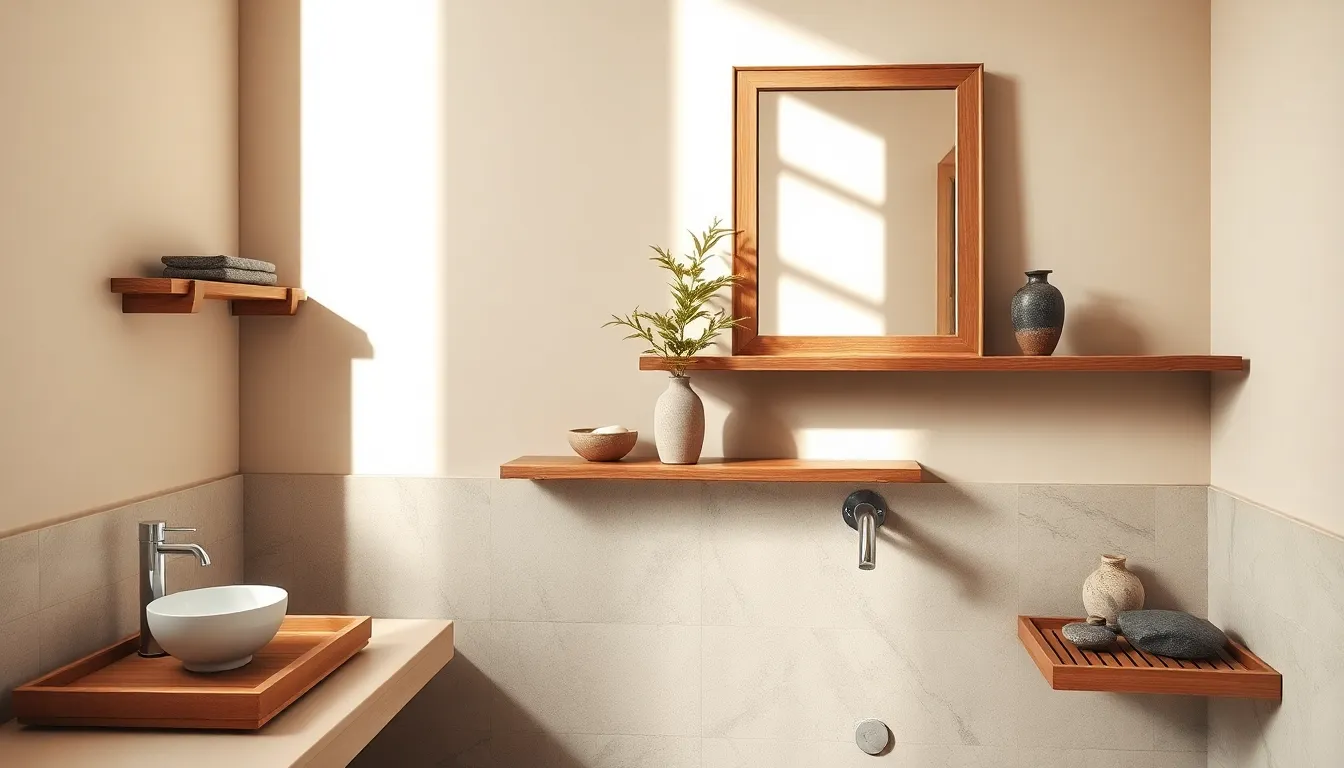
Creating a stunning Japandi bathroom doesn’t require a massive budget when you focus on strategic DIY projects and smart shopping. We can achieve this serene aesthetic through simple transformations that emphasize natural materials and minimalist design principles.
DIY Bamboo Projects
Bamboo shelves offer an affordable way to add natural warmth while providing essential storage for toiletries and bath essentials. We recommend using basic tools to create floating bamboo shelves that maintain the clean lines characteristic of Japandi design.
Wooden trays serve as functional organizers that bring organic texture to vanity surfaces and bathtub edges. These simple projects require minimal woodworking skills but deliver maximum visual impact.
Bamboo wall paneling creates stunning accent walls behind vanities using bamboo slats or rolls from home improvement stores. We can install these natural elements to add texture and visual interest without overwhelming the minimalist aesthetic.
Bamboo bath mats provide moisture resistant flooring answers that complement the sustainable material philosophy of Japandi design. These DIY projects help establish the natural foundation essential to this aesthetic approach.
Thrift Store Natural Materials
Stone soap dishes and ceramic vessels from secondhand stores offer authentic natural textures at fraction of retail prices. We’ve found that vintage ceramic pieces often embody the handcrafted quality that enhances the wabi-sabi philosophy.
Wood framed mirrors from thrift stores can be refinished to create focal points that reflect natural light and enhance the sense of openness. These finds provide the organic warmth needed to balance minimalist elements.
Vintage textiles in neutral tones serve multiple purposes as bath mats, window coverings, or storage basket liners. We recommend searching for linen and cotton pieces that align with the natural fiber emphasis of Japandi design.
Ceramic vases and pottery pieces add functional art elements that bring personality to the minimalist environment. These thrifted treasures often feature the imperfect beauty that defines authentic Japandi aesthetics.
Simple Paint Transformations
Accent walls painted in soft, matte colors like beige or warm gray create visual depth without disrupting the neutral color palette. We suggest choosing one wall behind the vanity to serve as a subtle focal point.
Vanity updates using matte paint in warm white or soft gray tones can transform existing furniture into cohesive Japandi elements. These simple transformations help unify the space while maintaining the clean line philosophy.
Fixture refreshes using spray paint in matte black or muted brass update older metal hooks, towel bars, and cabinet knobs. We recommend these strategic color updates to create cohesive hardware throughout the bathroom.
Tile refresh projects using specialized bathroom paint can update existing ceramic surfaces in neutral tones that support the overall aesthetic. These cost effective answers help achieve the unified color scheme essential to Japandi design success.
Conclusion
Creating our dream Japandi bathroom doesn’t require a complete overhaul or enormous budget. We’ve shown you how thoughtful choices in natural materials warm woods and calming neutral tones can transform any space into a serene retreat.
The beauty of this design approach lies in its flexibility. Whether we’re incorporating a single bamboo shelf or selecting a stunning cedar soaking tub we’re building toward the same goal: a harmonious balance of function and tranquility.
Remember that Japandi design celebrates quality over quantity. Every element we choose should serve a purpose while contributing to the overall sense of calm. By focusing on sustainable materials mindful color choices and clutter-free organization we create a bathroom that truly reflects this timeless aesthetic.
Start with one or two key elements and build from there. Our Japandi bathroom journey is about creating a personal sanctuary that brings peace to our daily routines.
Frequently Asked Questions
What is Japandi design and how does it apply to bathrooms?
Japandi design combines Japanese minimalism with Scandinavian functionality, creating spaces that emphasize clean lines, natural materials, and neutral colors. In bathrooms, this translates to uncluttered spaces featuring warm woods, stone elements, and a “less is more” philosophy that prioritizes quality fixtures and storage solutions while maintaining a serene, spa-like atmosphere.
What are the key elements of a Japandi bathroom design?
The essential elements include a minimalist aesthetic with clean lines, natural materials like sustainably sourced wood and stone, and a neutral color palette. Focus on functional furniture, ceramic and porcelain fixtures, warm white base colors with earth tones, and selective black accents to create a harmonious and practical retreat.
How can I achieve Japandi style on a budget?
Create DIY bamboo shelves and wooden trays for organization, add bamboo wall paneling for accent walls, and shop thrift stores for stone soap dishes and wood-framed mirrors. Simple paint transformations using warm whites and earth tones can unify your bathroom’s aesthetic without significant expense while maintaining the minimalist principles.
What types of plants work best in a Japandi bathroom?
Choose low-maintenance greenery that thrives in bathroom conditions, such as succulents, air plants, and pothos. These plants contribute to the calming ambiance while requiring minimal care. Display them in natural materials like wicker and bamboo containers to maintain the minimalist aesthetic and enhance the organic atmosphere.
What color scheme should I use for a Japandi bathroom?
Focus on three approaches: warm white base tones as a neutral foundation, earthy beige accents through textiles and stone elements, and soft gray combinations that balance warmth and coolness. This palette allows natural materials to shine while maintaining visual harmony and supporting the serene functionality of the space.
What fixtures best embody the Japandi aesthetic?
Select freestanding soaking tubs made from natural wood like cedar or teak, vessel sinks in ceramic or porcelain for minimalist appeal, and faucets with clean geometric designs. These fixtures should emphasize both Japanese simplicity and Scandinavian functionality while serving as focal points that enhance the spa-like atmosphere.
What textiles complement Japandi bathroom design?
Choose natural fibers that enhance comfort while maintaining minimalist principles. Cotton bath mats for moisture absorption, sisal mats for durability, bamboo fiber mats for sustainability, and linen towel collections in pure or stone-washed varieties. Organic cotton accessories reinforce the quality-over-quantity philosophy essential to Japandi design.







